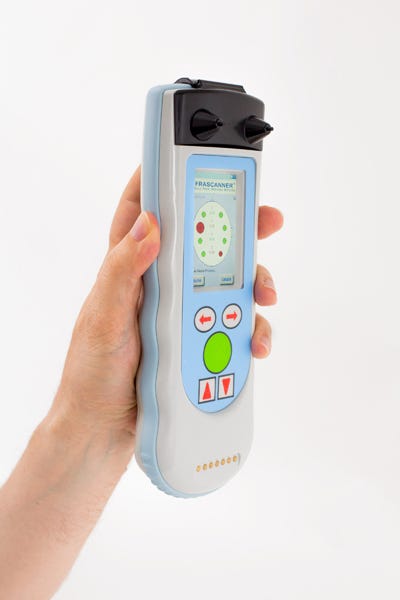NIR Brain Hematoma Detector Can Save Lives
April 22, 2013
|
A screening device that assists first responders and clinicians in the identification of brain hematomas, the Infrascanner Model 2000 uses near-infrared light to detect brain hematomas after traumatic brain injury. |
Usually the result of serious or minor head injuries, subdural hematomas cause blood to collect in the brain. At their worst, they can cause blood to fill the brain area very rapidly, compressing brain tissue and often resulting in death. Targeting this life-threatening condition, InfraScan Inc. (Philadelphia) has designed the Infrascanner Model 2000, a screening device that assists first responders and clinicians in the identification of brain hematomas. Chosen as a finalist for this year's Medical Design Excellence Awards (MDEA), this noninvasive, portable, handheld device will share the stage at the MDEA award ceremony, to be held June 19 in conjunction with MD&M East.
The Model 2000 imaging device uses near-infrared (NIR) light to detect brain hematomas after traumatic brain injury. "Acute hematomas result in an approximately tenfold greater concentration of hemoglobin than in normal brain tissue," explains David L. Solt, vice president R&D of InfraScan. "Because the absorption of NIR light is greater on the side of the brain containing a hematoma than on the side with no hematoma, our device can pinpoint where severe trauma has occurred." With the ability to detect the hematoma in patients before they are transported to a medical facility, proper intervention can begin to prevent further brain damage.
Until now, no handheld device has existed for helping clinicians determine whether a life-threatening brain bleed is occurring, Solt remarks. "Thus, we felt that the market needed a low-cost, rugged, lightweight, accurate, and effective tool that would be useful as a screening device at the places where acute traumatic brain injury occurs."
Once the need was identified, InfraScan faced a series of design and manufacturing challenges, the first of which was to develop a complex device that could fit into a space-restricted and ergonomic package, according to Solt. Then, the device had to be designed with patient safety in mind and to prevent ingress from both dust and water. Finally, the company had to develop suitable processes to consistently assemble and test the device based on stringent criteria.
To accomplish this mission, InfraScan turned to John Ferguson Design (Southampton, PA) and Inteprod LLC (Eagleville, PA) to assist in the design and manufacture of the device. "John Ferguson is an exceptionally creative person who understands well the interaction between design, function, and cost," Solt comments. "Inteprod, on the other hand, is an outstanding medical and diagnostics device contract manufacturer." With years of experience in medical device manufacturing, Inteprod's team was well qualified to assist in the manufacture of the Model 2000 and catered to InfraScan's every whim and desire," Solt adds. "In addition to meeting difficult deadlines, it was quick to offer suggestions for improving the design and the manufacturing processes."
"I was charged with creating an aesthetically pleasing, functional device," remarks John Ferguson. "In addition, I was responsible for ensuring that all of the device's mechanical items functioned as they should." For example, Ferguson's task was to ensure that the disposable shield would snap on and off and that it was positioned precisely over the laser and detector. The biggest challenge of all, however, was fitting all of the components into a small handheld unit.
On the production side, Inteprod was tasked with performing a range of services, including design for manufacturing, tooling and injection-molding support, development and implementation of manufacturing processes, manufacturing validation, quality assurance and compliance, supply-chain management, and device manufacturing, service, and distribution.
"Based on the Infrascanner 1000, which featured a handheld sensor and a separate PDA to display the results, the Model 2000 incorporates the PDA functions into the handheld sensor," remarks Rick Smethers, CEO and CTO of Inteprod. "Our role included integrating the processing, display, and control functions of the separate PDA into the sensor; ruggedizing the system to achieve improved durability; and manufacturing a unit that could accommodate regular AA batteries, in addition to a rechargeable battery pack."
One of several challenges the manufacturer encountered was determining how to send NIR light through bone with enough signal to be able to interpret the response. This challenge, according to Smethers, was met by utilizing a laser source, a narrow band-pass optical filter, and high-gain, low-noise amplifiers.
Another challenge was to prevent ambient light, which is rich in infrared components, from interfering and distorting the detection results. Preventing this interference required a significant design effort, which involved the introduction of a lock-in amplifier to filter out extraneous infrared light, Smethers says.
A third challenge was dealing with human hair, which is very efficient at blocking infrared light. "The development of disposable light guides that can comb through the hair to the scalp afforded a cost-effective solution," Smethers comments. "Figuring out this technology and pairing it with a high-resolution color display system for rapid viewing via graphic imaging was a quite an accomplishment."
Capable of providing a simple positive or negative graphic report in two to three minutes, the Infrascanner is an accurate, low-cost detection device that can be used as an extension of a routine neurological examination, Smethers concludes. "The early identification of a brain hematoma can play a significant role in facilitating transportation of critically injured patients to facilities, which can both confirm Infrascanner's early diagnosis and also aid in surgical intervention."
About the Author(s)
You May Also Like



